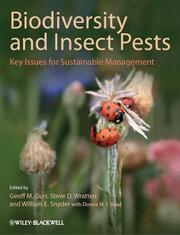Detailansicht
Biodiversity and Insect Pests
Key Issues for Sustainable Management
ISBN/EAN: 9780470656860
Umbreit-Nr.: 3208626
Sprache:
Englisch
Umfang: 360 S.
Format in cm:
Einband:
gebundenes Buch
Erschienen am 19.04.2012
Auflage: 1/2012
- Zusatztext
- Biodiversity offers great potential for managing insect pests. It provides resistance genes and anti-insect compounds; a huge range of predatory and parasitic natural enemies of pests; and community ecology-level effects operating at the local and landscape scales to check pest build-up. This book brings together world leaders in theoretical, methodological and applied aspects to provide a comprehensive treatment of this fast-moving field. Chapter authors from Europe, Asia, Africa, Australasia and the Americas ensure a truly international scope. Topics range from scientific principles, innovative research methods, ecological economics and effective communication to farmers, as well as case studies of successful use of biodiversity-based pest management some of which extend over millions of hectares or are enshrined as government policy. Written to be accessible to advanced undergraduates whilst also stimulating the seasoned researcher, this work will help unlock the power of biodiversity to deliver sustainable insect pest management. Visit www.wiley.com/go/gurr/biodiversity to access the artwork from the book.
- Kurztext
- Biodiversity offers great potential for managing insect pests. It provides resistance genes and anti-insect compounds; a huge range of predatory and parasitic natural enemies of pests; and community ecology-level effects operating at the local and landscape scales to check pest build-up. This book brings together world leaders in theoretical, methodological and applied aspects to provide a comprehensive treatment of this fast-moving field. Chapter authors from Europe, Asia, Africa, Australasia and the Americas ensure a truly international scope. Topics range from scientific principles, innovative research methods, ecological economics and effective communication to farmers, as well as case studies of successful use of biodiversity-based pest management some of which extend over millions of hectares or are enshrined as government policy. Written to be accessible to advanced undergraduates whilst also stimulating the seasoned researcher, this work will help unlock the power of biodiversity to deliver sustainable insect pest management.
- Autorenportrait
- InhaltsangabePreface, vii Foreword, ix Contributors, x INTRODUCTION, 1 1 Biodiversity and insect pests, 3 Geoff M. Gurr, Steve D. Wratten and William E. Snyder FUNDAMENTALS, 21 2 The ecology of biodiversity-biocontrol relationships, 23 William E. Snyder and Jason M. Tylianakis 3 The role of generalist predators in terrestrial food webs: lessons for agricultural pest management, 41 K.D. Welch, R.S. Pfannenstiel and J.D. Harwood 4 Ecological economics of biodiversity use for pest management, 57 Mark Gillespie and Steve D. Wratten 5 Soil fertility, biodiversity and pest management, 72 Miguel A. Altieri, Luigi Ponti and Clara I. Nicholls 6 Plant biodiversity as a resource for natural products for insect pest management, 85 Opender Koul 7 The ecology and utility of local and landscape scale effects in pest management, 106 Sagrario Gámez-Virués, Mattias Jonsson and Barbara Ekbom METHODS, 121 8 Scale effects in biodiversity and biological control: methods and statistical analysis, 123 Christoph Scherber, Blas Lavandero, Katrin M. Meyer, David Perovic, Ute Visser, Kerstin Wiegand and Teja Tscharntke 9 Pick and mix: selecting flowering plants to meet the requirements of target biological control insects, 139 Felix L. Wäckers and Paul C.J. van Rijn 10 The molecular revolution: using polymerase chain reaction based methods to explore the role of predators in terrestrial food webs, 166 William O.C. Symondson 11 Employing chemical ecology to understand and exploit biodiversity for pest management, 185 David G. James, Sofia Orre-Gordon, Olivia L. Reynolds (née Kvedaras) and Marja Simpson APPLICATION, 197 12 Using decision theory and sociological tools to facilitate adoption of biodiversity-based pest management strategies, 199 M.M. Escalada and K.L. Heong 13 Ecological engineering strategies to manage insect pests in rice, 214 Geoff M. Gurr, K.L. Heong, J.A. Cheng and J. Catindig 14 China's 'Green Plant Protection' initiative: coordinated promotion of biodiversity-related technologies, 230 Lu Zhongxian, Yang Yajun, Yang Puyun and Zhao Zhonghua 15 Diversity and defence: plant-herbivore interactions at multiple scales and trophic levels, 241 Finbarr G. Horgan 16 'Pushpull' revisited: the process of successful deployment of a chemical ecology based pest management tool, 259 Zeyaur R. Khan, Charles A.O. Midega, Jimmy Pittchar, Toby J.A. Bruce and John A. Pickett 17 Using native plant species to diversify agriculture, 276 Douglas A. Landis, Mary M. Gardiner and Jean Tompkins 18 Using biodiversity for pest suppression in urban landscapes, 293 Paula M. Shrewsbury and Simon R. Leather 19 Cover crops and related methods for enhancing agricultural biodiversity and conservation biocontrol: successful case studies, 309 P.G. Tillman, H.A. Smith and J.M. Holland SYNTHESIS, 329 20 Conclusion: biodiversity as an asset rather than a burden, 331 Geoff M. Gurr, William E. Snyder, Steve D. Wratten and Donna M.Y. Read Index, 340 Colour plates fall between pages 84 and 8
